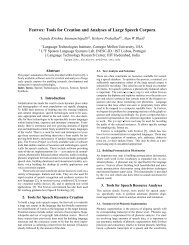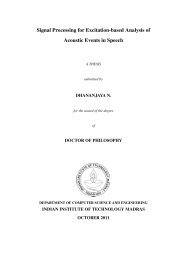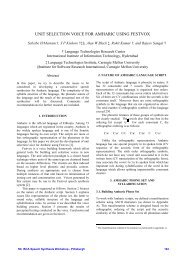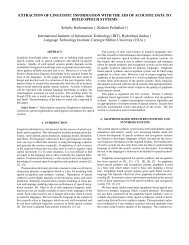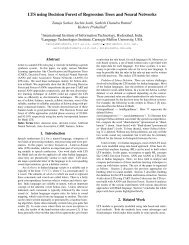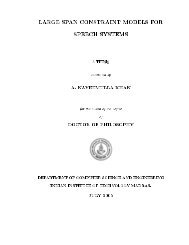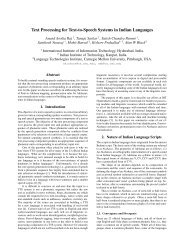word boundary- hypothesisation in hindi speech - Speech and ...
word boundary- hypothesisation in hindi speech - Speech and ...
word boundary- hypothesisation in hindi speech - Speech and ...
You also want an ePaper? Increase the reach of your titles
YUMPU automatically turns print PDFs into web optimized ePapers that Google loves.
aapteT I<br />
INTRODUCTION TO WORD BOVNDARY HYPOTHESISATION<br />
1.1 Word <strong>boundary</strong> <strong>hypothesisation</strong> problem<br />
The problcrn of wzlrd <strong>boundary</strong> hyp~thesisation(Wl3H) arises <strong>in</strong> the contcxi "i'<br />
human communication with mach<strong>in</strong>es. The problem can be stated as follows: Given a<br />
str<strong>in</strong>g of symbols represent<strong>in</strong>g a sentence, <strong>word</strong> boundaries are to be placed <strong>in</strong> the<br />
symbol str<strong>in</strong>g to convert it <strong>in</strong>to a str<strong>in</strong>g of <strong>word</strong>s. This problem is relevant especially <strong>in</strong><br />
the context of <strong>speech</strong> <strong>in</strong>put to a mach<strong>in</strong>e, where the speaker does not consciously<br />
<strong>in</strong>dicate the <strong>word</strong> boundaries while speak<strong>in</strong>g. The work reported <strong>in</strong> this thesis is on the<br />
identification of clues to perform <strong>word</strong> <strong>boundary</strong> <strong>hypothesisation</strong> <strong>in</strong> a <strong>speech</strong>-to-text<br />
conversion system for the Indian language H<strong>in</strong>di.<br />
The role of the <strong>word</strong> <strong>boundary</strong> <strong>hypothesisation</strong> problem <strong>in</strong> <strong>speech</strong> recognition<br />
can be understood if one exam<strong>in</strong>es the way humans speak. Normal <strong>speech</strong> is a<br />
sequence of sounds with very few pauses to <strong>in</strong>dicate <strong>word</strong> boundaries. To convert<br />
<strong>speech</strong> <strong>in</strong>to the correspond<strong>in</strong>g text, one needs to identify the positions of the miss<strong>in</strong>g<br />
<strong>word</strong> boundaries. In <strong>speech</strong> recognition systems, the <strong>word</strong> boundaries may be obta<strong>in</strong>ed<br />
by match<strong>in</strong>g a symbolic representation of the <strong>speech</strong>, produced by a <strong>speech</strong> signal-to-<br />
symbol converter, aga<strong>in</strong>st a lexicon. However, this process, called lexical analysis,<br />
produces a large number of alternate <strong>word</strong> str<strong>in</strong>gs, when the <strong>in</strong>put symbol sequence<br />
conta<strong>in</strong>s errors. Moreover, it also <strong>in</strong>volves a large number of computations. S<strong>in</strong>ce a<br />
significant percentage of the <strong>speech</strong> recognition time is spent on lexical ~nalysis [Wolf<br />
<strong>and</strong> Woods 19801, one needs to simplify the lexical analysis to speed up the <strong>speech</strong><br />
recognition. If some <strong>word</strong> boundaries can be identified before perform<strong>in</strong>g lexical<br />
analysis, the performance of the lexical analyser, both <strong>in</strong> number of computations <strong>and</strong><br />
<strong>in</strong> accuracy, can be significantly improved.<br />
Consider the operation of a lexical analyser when some <strong>word</strong> boundaries are





